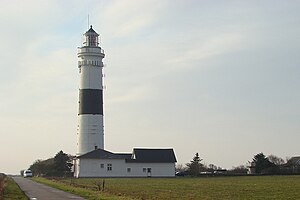Kampen lighthouse
| Kampen lighthouse | ||
|---|---|---|
| View of Kampen (north) | ||
| Place: | Kampen | |
| Location: | on the island of Sylt, south of Kampen | |
| Geographical location: | 54 ° 56 '46.4 " N , 8 ° 20' 26.4" E | |
| Height of tower base: | 22 m above sea level NHN | |
| Fire carrier height : | 40 m | |
| Fire height : | 62 m | |
|
|
||
| Identifier : | LFl.WR.10s | |
| Scope knows: | 20 nm (37 km ) | |
| Scope red: | 16 nm (29.6 km ) | |
| Optics: | Belt lens | |
| Operating mode: | electric, metal halide lamp 400 W / 230 V. | |
| Function: | Orientation fire | |
| Construction time: | 1856 | |
| Operating time: | since March 1, 1856 | |
| International ordinal number: | B 1740 | |
The Kampen lighthouse (also known as the Rotes Kliff or Rote Kliff lighthouse ) is located near Kampen on the Geest core of the island of Sylt. The white tower has a black ribbon.
history
At the time when Sylt was part of the Danish kingdom , King Frederick VII of Denmark commissioned the construction of a lighthouse on the highest point of the island, the Red Cliff, in 1853 . The original name of this beacon was therefore Red Cliff . It was renamed Kampen lighthouse in 1975. On March 1, 1856 , its fire shone for the first time. The originally used light device with petroleum feed was at that time a technical revolution, which was shown at the world exhibition in Paris in 1855 .
The tower was made of yellow Bornholmer clinker brick. Iron rings, which were also placed around the tower as iron corset rings in 1875, give the structure additional strength.
Until 1953 the tower was yellow-gray, the color of the weathered clinker brick. Only then did it receive its distinctive black and white day identifier .
In the first few years after its construction, the lighthouse became a popular attraction for guests and locals. Preserved guest books from the 1870s and 1880s clearly demonstrate this. At that time - unlike today - the tower could still be viewed and climbed. It offered visitors a spectacular view over large parts of the island.
In 1929 the tower underwent its largest renovation to date, the lamp house was completely rebuilt and the lighthouse switched from petroleum to electrical operation.
There have been no beacon keepers in Kampen since 1977 , since then the tower, like all other Sylt beacons that are still active, has been remote-controlled via a radio timer. Its fire wakes up about an hour before sunset and goes out an hour after sunrise.
The tower only had to fear for its existence once in its 150-year history. Wehrmacht plans envisaged leveling large parts of the Braderup Heide - where the tower is also located - for the expansion of the air base and to blow up the Kampen lighthouse. However, these plans became obsolete with the occupation of Denmark and Norway , as the strategic importance of Sylt had now decreased significantly.
In 2004 and 2005 the tower was extensively renovated and was completely scaffolded for several months. On June 4, 2006, on the occasion of the 150th anniversary of the beacon, there was a large "tower festival"; there was the rare opportunity to visit and climb the newly renovated tower. The tickets were raffled off.
In art
Due to its distinctive black and white coloring, this lighthouse is a popular motif in painting. In addition to lesser-known artists, painters such as Ole West and Hans Nordmann have chosen the tower as the motif of their works.
See also
Web link
- 360 degree panorama, lamp house Leuchtfeuer Kampen , homepage Wasserstraßen- und Schifffahrtsamt Tönning
- 360 degree panorama, Galerie Leuchtfeuer Kampen , homepage Wasserstraßen- und Schifffahrtsamt Tönning
Individual evidence
- ↑ www.sylt-lexikon.de , accessed on November 1, 2011
- ↑ www.nordseeinseln-erleben.de , accessed on March 19, 2017
- ^ Birgit Toussaint, Frank Toussaint, Matthias Hünsch: Lighthouses on the German North Sea coast. Edition Maritim 2009, ISBN 978-3-89225-606-9 .
- ↑ www.baken.net , accessed on March 19, 2017




